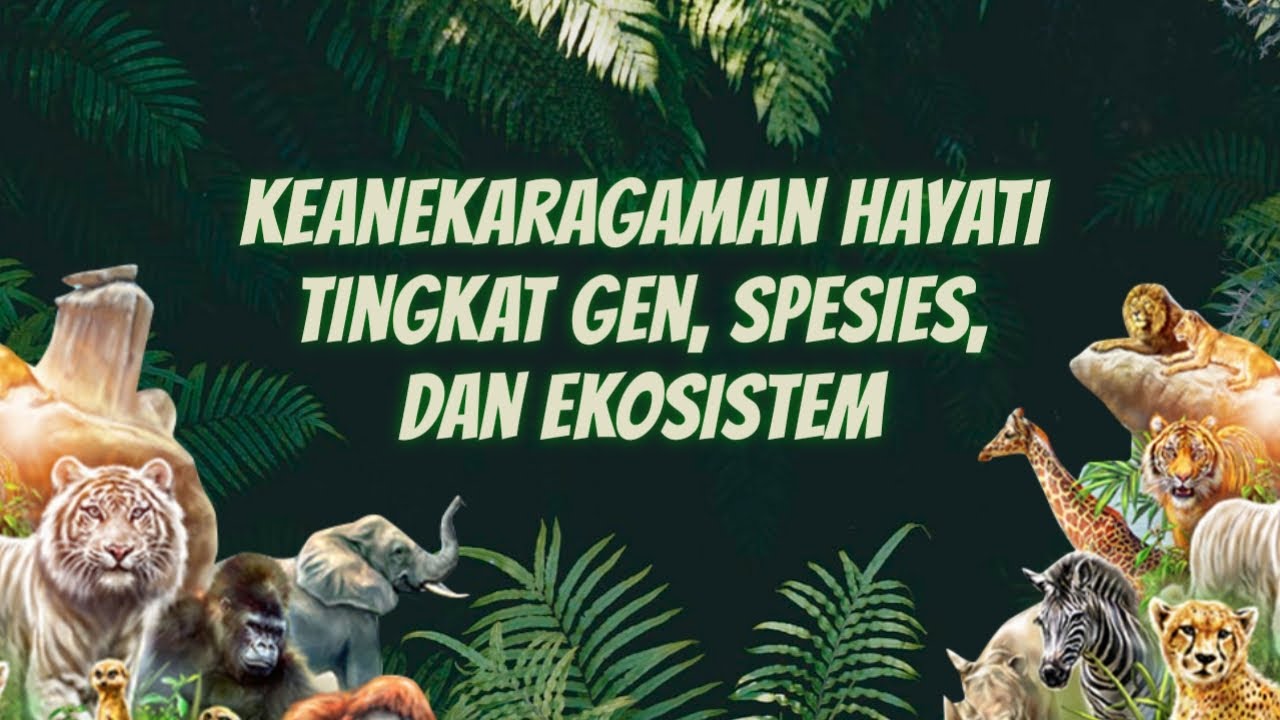Keanekaragaman Mahluk Hidup
Summary
TLDRThis educational video discusses biodiversity, emphasizing the variety of life forms at genetic, species, and ecosystem levels. It explores how variations exist within species, like cattle, and the significance of ecosystem diversity, highlighting the impact of human activities on ecological balance. The classification of living organisms is traced from early systems proposed by Aristotle to modern classifications that now encompass five to six kingdoms. The video also addresses the consequences of mismanagement of natural resources, such as habitat destruction and the emergence of new diseases, underlining the importance of sustainable practices to maintain biodiversity.
Takeaways
- 🌱 Biodiversity refers to the variety of living organisms, including genetic variation, species diversity, and ecosystem diversity.
- 🧬 Genetic diversity within a species is illustrated through the variations found in livestock, such as different breeds of cattle.
- 🐄 Different cattle breeds, such as Angus, Holstein, and Wagyu, exhibit significant genetic diversity while belonging to the same species.
- 🌍 Ecosystem diversity varies greatly depending on the habitat, with distinct differences between grasslands, mangroves, lakes, and oceans.
- 📈 The number of living organisms is vast, with billions of species identified, and new species continually being discovered.
- 🔍 Classification of living organisms is essential for understanding their relationships and characteristics, starting from the work of Carolus Linnaeus.
- 📊 Linnaeus' classification system divides life into hierarchical categories, including Kingdom, Phylum, Class, Order, Family, Genus, and Species.
- 🏰 The Kingdom classification has evolved over time, initially proposing two kingdoms (Plantae and Animalia) and later expanding to five and six kingdoms.
- ⚠️ Human activities, such as habitat destruction and pollution, pose significant threats to biodiversity and can lead to species extinction.
- 🌐 The impact of climate change and the introduction of invasive species disrupt ecosystems, highlighting the importance of sustainable environmental management.
Q & A
What is the definition of biodiversity as discussed in the transcript?
-Biodiversity refers to the variety of life forms on Earth, including genetic diversity within species, species diversity among different species, and ecosystem diversity in various habitats.
How is genetic diversity exemplified in the context of cattle?
-Genetic diversity in cattle is illustrated through different breeds, such as Holstein, Angus, and Indonesian breeds like Bali and Madura, which all belong to the species Bos taurus.
What are the three main levels of biodiversity mentioned?
-The three main levels of biodiversity are genetic diversity, species diversity, and ecosystem diversity.
What historical figure is credited with the early classification of living organisms, and what was his approach?
-Carolus Linnaeus is credited with the early classification of living organisms, which was based on structural similarities among species.
How has the classification of living organisms evolved over time?
-The classification has evolved from two kingdoms (Plantae and Animalia) to six kingdoms, including Monera, Protista, Fungi, Plantae, and Animalia, reflecting advances in biological understanding.
What impact does habitat destruction have on biodiversity?
-Habitat destruction disrupts ecological balance, leading to the loss of species and a decline in biodiversity.
What are some examples of human activities that negatively affect biodiversity?
-Examples include pollution from industrial waste, habitat destruction due to urban expansion, introduction of invasive species, and over-exploitation of natural resources.
What role do emerging diseases play in the context of biodiversity?
-Emerging diseases, such as COVID-19, can be linked to environmental disruptions and human encroachment on natural habitats, impacting both wildlife and human health.
Why is it important to understand and study biodiversity?
-Understanding biodiversity is crucial for maintaining ecological balance, ensuring sustainable resource management, and preserving the planet's health for future generations.
What does the term 'invasive species' mean, and why is it a concern for biodiversity?
-Invasive species are non-native organisms introduced to a new environment, where they can outcompete local species, disrupt ecosystems, and lead to a decline in native biodiversity.
Outlines

Этот раздел доступен только подписчикам платных тарифов. Пожалуйста, перейдите на платный тариф для доступа.
Перейти на платный тарифMindmap

Этот раздел доступен только подписчикам платных тарифов. Пожалуйста, перейдите на платный тариф для доступа.
Перейти на платный тарифKeywords

Этот раздел доступен только подписчикам платных тарифов. Пожалуйста, перейдите на платный тариф для доступа.
Перейти на платный тарифHighlights

Этот раздел доступен только подписчикам платных тарифов. Пожалуйста, перейдите на платный тариф для доступа.
Перейти на платный тарифTranscripts

Этот раздел доступен только подписчикам платных тарифов. Пожалуйста, перейдите на платный тариф для доступа.
Перейти на платный тарифПосмотреть больше похожих видео

Keanekaragaman Hayati Kelas 10

Keanekaragaman Hayati | Belajar online mapel biologi

UAS PLH KEANEKARAGAMAN HAYATI - ARSYA DWI GUSTAMI - 210210201082

Keanekaragaman Hayati Tingkat Gen, Spesies, dan Ekosistem | Dunia Biologi

Lesson 13: Biodiversity

Science, Technology and Society: Biodiversity and Healthy Society
5.0 / 5 (0 votes)
